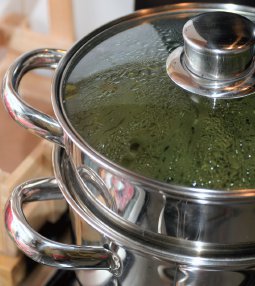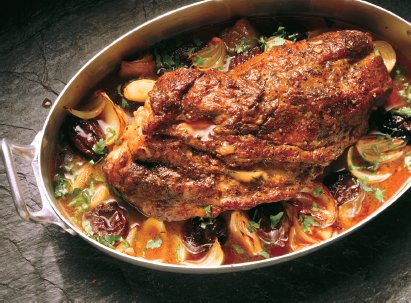Eleven
Quick & Clean Cooking Techniques and Restaurant Rules
Assuming that you won’t be hiring a personal chef anytime soon, the best way to take control of your eating is to cook for yourself. I’m not suggesting that you take a course at the Cordon Bleu or become a contestant on the next season of Top Chef, but if—like many Americans—you’ve been eating most of your meals out, you’ll need to master a few of the techniques used in the recipes I provide. I’m not suggesting that you never go to a restaurant again—in fact, we’ll be talking about that in this chapter as well. The recipes aren’t difficult, and once you’ve mastered them, you’ll be able to make any number of quick, healthy meals for yourself and your family.
When you’re using good, fresh ingredients, simplest is often the best. Quick & Clean cooking works because it doesn’t require a lot of preparation or a long list of fancy ingredients. The idea is never to be hungry, so I don’t want you to be bogged down slaving in the kitchen.
Lean Cooking Techniques
One of the simplest ways to make your food leaner is to prepare it in a healthy manner. That’s why I’d like to walk you through some of the most slimming cooking methods. You can refer to these techniques when preparing the recipes in this book or invent new ones of your own.
Steaming is a form of “wet cooking” used primarily for vegetables, fish, and chicken, and is about as clean as it gets. Steaming helps retain most of the vitamins and minerals that are often lost when proteins or vegetables are cooked directly at high temperatures. You will notice that steamed foods also retain their gorgeous, natural bright color and crisp texture.

To steam food you will need a metal steam basket, a pot with steam holes, or an inexpensive bamboo basket. Fill a saucepan with about an inch and a half of water. Place the steam basket in the saucepan (making sure that it doesn’t become submerged in the water) and bring the water to a boil. When the water is boiling, place food in the steam basket and cover the pot with a tight-fitting lid. Depending upon the food, steaming should take only a few minutes, because the steam is so hot. When food is bright in color and tender, it is done. If you are cooking vegetables, be sure they are still somewhat crisp; you don’t want mushy vegetables.
Poaching: This very delicate way to prepare foods keeps the flavors and aromas from breaking down during the cooking process. There are so many great things about poaching: It’s very quick, it requires no added fat, you can add herbs and/or broth or stock to the poaching water for extra flavor, and you don’t need any special equipment. All you need is a basic saucepan and you’re ready to go. Poaching is great for delicate proteins like fish, but it also works well with chicken. You will notice that poaching leaves foods with a kind of silky finish.
To poach, place your ingredients in a saucepan and add water. Bring the liquid to a boil and reduce the heat to a simmer. Food is done when it is firm and opaque.
Grilling: Simple and so tasty! Grilling is an American pastime, but it also can be a low-fat, flavorful way to cook. Dry heat from the grill smokes and sears the food. Don’t you love those grill lines? And here’s what’s so great: The fat actually melts off the meat and drops to the bottom of the grill; whatever is left can be easily trimmed. Marinades, rubs, and brines are all great ways to kick up the flavor of grilled food. Don’t forget that grilling is not just for meat and poultry: Fish, vegetables, tofu, even fruit all work great on the grill.
Stir-frying is a tasty way to prepare foods quickly. A key cooking method in Asian countries, it has become an American favorite as well. Unlike deep-fat frying, or breading and frying, stir-frying uses very little fat, and the food is constantly moving in the pan so it doesn’t sit in fat while it’s cooking. One thing to remember is that the foods that take longest to cook should be added to the pan first, followed by those that cook more quickly. Stir-frying is a great option for vegetarian meals, and you shouldn’t feel that you need to go out and buy a wok in order to try it. Any skillet set over high heat will work just as well. The trick is to keep stirring!

Roasting takes longer than the cooking methods above; still, after you put the food in the oven it doesn’t need much tending, so you can just go about your other business while it cooks. Roasting is the process of dry-heat cooking that basically uses hot air to dry your food. It’s delicious because this method of cooking allows the natural juices and added spices to concentrate, which brings out the full flavor in meat, poultry, fish, and vegetables. It leaves food tender on the inside and crisp or caramelized on the outside. Temperatures depend on the density of the food that you are cooking, and recipes will indicate set temperature, but it’s usually at least 300 degrees or hotter.
Restaurant Rules—How to Survive Eating Out
It would be unrealistic to think that you can always eat at home or bring prepared food with you wherever you go—besides, sometimes it’s fun to eat out. But you need to be armed with some guidelines so you don’t sabotage everything you’ve worked for. And I don’t know about you, but when I’m trying to lose a few pounds, eating in restaurants makes me nervous.
I have a hard time passing up all those tasty-sounding foods on the menu, especially when whomever I’m with seems to be ordering with abandon and eating everything in sight. Well, now neither one of us has to think that way anymore, nor do we have to feel anxious about going out to eat. I have thought this through for both of us, and I believe my suggestions will work for you as they have for me. The next time you go to a restaurant, consider these strategies:
Don’t go famished: That’s simply setting yourself up to fail. Foods that normally wouldn’t tempt you will now taunt you because you’re ravenous! Don’t put yourself in that position. Instead of “saving up” your calories by skipping your afternoon snack, eat the snack. The whole point of having snacks on the meal plan is to keep you from becoming too hungry—ever. That’s the point. Then go to the restaurant as a rational human being, not a crazed diet fiend.
Read the menu in advance: Almost every restaurant has a website, and almost every website includes menus, so check it out. If you know what you’re going to eat before you get there, you’ll be much less likely to succumb to temptation.
Nix the bread: Even if you’re at a stage when you can have a slice or two of whole wheat bread, confronting that bread basket is just too tempting. If your dinner companion agrees, just ask the waitperson not to leave it on the table. Or, if the person you’re eating with does want some bread, ask him or her to put a slice or two on a bread plate and then ask the waiter to remove the basket.
Ask to have it your way: You can always ask to have something steamed or broiled without butter or oil instead of sautéed or fried. You can ask to have extra vegetables instead of potatoes. You may already be asking to have your salad dressing “on the side,” and this is just one more request you can make to avoid diet disaster. I’ve found that it’s very rare for a chef or a restaurant not to accommodate any reasonable request.
Take it to go: You’re not a child anymore, and you don’t have to belong to the clean plate club. Most restaurant portions are much larger than those we would make for ourselves at home, which is one of the dangers of eating in restaurants. So by all means ask for a doggie bag, whether or not you have a dog. And if you think looking at all that food will be too tempting, ask your server to wrap some of it up before you even begin. Or split an entree with your dining companion. Many restaurant meals are definitely big enough for two. I want you to go home feeling satisfied, not stuffed or as if you need to be rolled out the door.
By now you’ve agreed to make a change in your life. While you’re in this mind-set, let’s talk about exercise. It should never be overwhelming, so don’t overthink this. I’m just talking about movement—something, anything. Let’s take a look at simple things you can do.
